Previous Chapter
Wednesday 4thJune 2008
North Queensferry to Dunblane
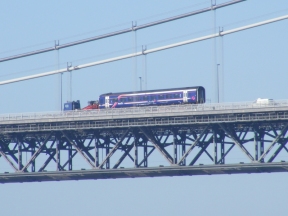 We woke to a beautiful sunny morning – there was even a train crossing the road bridge! Christine was treated to some proper porridge for breakfast. The Sustrans cycle route I had previously found to take us to Dunblane involved cycling along the north side of the Firth of Forth through Rosyth and Culross. During the week before leaving I had stumbled across a new cycle route which had been opened along a disused railway track from Dunfermline to Alloa. This would also give us the opportunity to visit Dunfermline Abbey so with some uncertainty about the surface of the track this is what we decided to do.
We woke to a beautiful sunny morning – there was even a train crossing the road bridge! Christine was treated to some proper porridge for breakfast. The Sustrans cycle route I had previously found to take us to Dunblane involved cycling along the north side of the Firth of Forth through Rosyth and Culross. During the week before leaving I had stumbled across a new cycle route which had been opened along a disused railway track from Dunfermline to Alloa. This would also give us the opportunity to visit Dunfermline Abbey so with some uncertainty about the surface of the track this is what we decided to do.
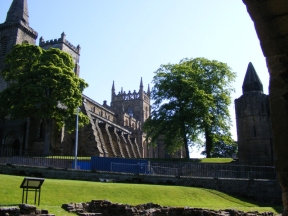 It was an easy ride into Dunfermline and we were soon standing in the Abbey grounds which has strong connections with King Robert the Bruce. The Abbey was founded in 1128 by King David I of Scotland son of King Malcolm III and his wife Margaret. Dunfermline became the centre for the cult of St Margaret and their tombs lie within the ruined walls of the Lady Chapel. A funeral service was taking place when we arrived so we visited the Dunfermline Palace ruins while we waited. The Palace was a favourite residence of the Scottish monarchs from 1500 up to 1650 (James IV through to Charles II) and, with the exception of Iona, the Abbey itself holds the remains of more Scottish royalty than anywhere else. Robert the Bruce was buried here in 1329.
It was an easy ride into Dunfermline and we were soon standing in the Abbey grounds which has strong connections with King Robert the Bruce. The Abbey was founded in 1128 by King David I of Scotland son of King Malcolm III and his wife Margaret. Dunfermline became the centre for the cult of St Margaret and their tombs lie within the ruined walls of the Lady Chapel. A funeral service was taking place when we arrived so we visited the Dunfermline Palace ruins while we waited. The Palace was a favourite residence of the Scottish monarchs from 1500 up to 1650 (James IV through to Charles II) and, with the exception of Iona, the Abbey itself holds the remains of more Scottish royalty than anywhere else. Robert the Bruce was buried here in 1329.
It was late morning when we left the Abbey in search for a tea shop in town and somewhere to buy provisions for lunch. A local resident guided us to the best café. With energy levels restored and calories in the panniers for later we sought directions for the cycle track from a traffic warden. She wasn’t 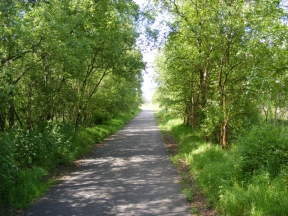 too sure but we got a rough idea of where it was and we soon found the cycle route signs taking us westwards. What I failed to notice on my map was that there was a slight kink in the cycle route as it crossed a main road and we ended up on a farm track with a very poor surface – can this really be the cycle track? A half a mile down the track it suddenly turned off to the south and then 100 yards later into a farm – we had come the wrong way. We retraced our steps carefully to the road (the surface of the track made riding and steering difficult). Down the main road for 100 yards and we came to the proper track – beautifully tarmacked, lovely to ride on. This track was to take us to the outskirts of Clackmannan and it was deserted apart from two other cyclists. From there we were soon in Alloa sitting on the benches outside Tesco’s Supermarket eating our lunch. It is a pity that this cycle route is so under-utilised and it appears that council funds don’t run to advertising it.
too sure but we got a rough idea of where it was and we soon found the cycle route signs taking us westwards. What I failed to notice on my map was that there was a slight kink in the cycle route as it crossed a main road and we ended up on a farm track with a very poor surface – can this really be the cycle track? A half a mile down the track it suddenly turned off to the south and then 100 yards later into a farm – we had come the wrong way. We retraced our steps carefully to the road (the surface of the track made riding and steering difficult). Down the main road for 100 yards and we came to the proper track – beautifully tarmacked, lovely to ride on. This track was to take us to the outskirts of Clackmannan and it was deserted apart from two other cyclists. From there we were soon in Alloa sitting on the benches outside Tesco’s Supermarket eating our lunch. It is a pity that this cycle route is so under-utilised and it appears that council funds don’t run to advertising it.
The Sustrans cycle route from Alloa to Stirling takes a devious route from here on. We soon got lost in the park adjacent to Tesco as re-construction work was taking place and the detour signs seemed to lead to nowhere. A helpful resident put us right and we were back onto a very quiet lane leading out of the town towards to village of Cambus south of Tullibody. Having crossed the River Devon (a small river flowing into the Forth) we found ourselves on a dirt track skirting a nature reserve. To begin with we had to walk, but after a few hundred yards its condition improved and we were able to ride. Eventually, after what seemed like miles but was probably only one mile, we found ourselves on the perimeter of an industrial estate with tight security (in fact a bonded warehouse) and from there it was a short distance back onto the main road leading towards Bridge of Allan. Officially this was 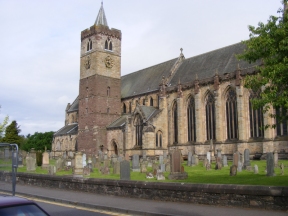 the main A9 trunk road but, as the motorway ran fairly close, the traffic wasn’t too heavy and we were soon in the town supping tea – the most expensive of the trip at £3.90 for two. Just 3 miles left now to reach our destination in Dunblane at 4.00pm and our B&B for the night in Cathedral Square with its bedroom window overlooking the cathedral.
the main A9 trunk road but, as the motorway ran fairly close, the traffic wasn’t too heavy and we were soon in the town supping tea – the most expensive of the trip at £3.90 for two. Just 3 miles left now to reach our destination in Dunblane at 4.00pm and our B&B for the night in Cathedral Square with its bedroom window overlooking the cathedral.
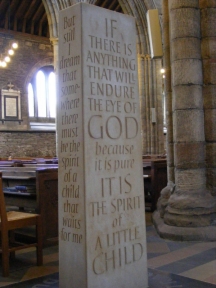 There was time left to tour the cathedral before it closed at 5.30. Dunblane sticks in our minds for the terrible tragedy which took place there in 1996 when 16 children and a teacher were brutally killed. There is a memorial inside the church to mark this event. It brings back very sad memories. The Cathedral belongs to the Church of Scotland – there is now no Bishop or Cathedra. The present building originates from about 1233 when Clement became Bishop but there are records showing that Christianity was first established here by St Blane around the year 600. The standing stone cross inside the church is said to date from the 9th century. Around the time of the protestant reformation, the choir was the only part of the church which was in use and the rest of the fabric deteriorated resulting in the collapse of the roof of the nave. It remained like this for about 300 years until the late 1800’s when the whole church was restored.
There was time left to tour the cathedral before it closed at 5.30. Dunblane sticks in our minds for the terrible tragedy which took place there in 1996 when 16 children and a teacher were brutally killed. There is a memorial inside the church to mark this event. It brings back very sad memories. The Cathedral belongs to the Church of Scotland – there is now no Bishop or Cathedra. The present building originates from about 1233 when Clement became Bishop but there are records showing that Christianity was first established here by St Blane around the year 600. The standing stone cross inside the church is said to date from the 9th century. Around the time of the protestant reformation, the choir was the only part of the church which was in use and the rest of the fabric deteriorated resulting in the collapse of the roof of the nave. It remained like this for about 300 years until the late 1800’s when the whole church was restored. 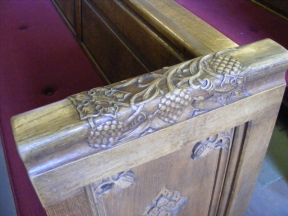 Consequently most of the fabric of the church dates from early 1900, although some of the very early choir stalls are on display at the east end. There are many examples of fine carving inside the church – the pew ends are individually decorated and the carvings in the choir contain a whole menagerie of animals. The pulpit it also richly carved with figures reflecting the history of the Cathedral including St Blane, King David I, Saint Clement, John Knox and Robert Leighton, Bishop of Dunblane from 1662 to 1671 (he had strong Presbyterian leanings which eventually led to him resigning as Archbishop of Glasgow in 1674). Note that the last Bishop of Dunblane, Robert Douglas, left in 1689 when episcopacy was abolished in the Church of Scotland. The cathedral also contains some fine stained glass.
Consequently most of the fabric of the church dates from early 1900, although some of the very early choir stalls are on display at the east end. There are many examples of fine carving inside the church – the pew ends are individually decorated and the carvings in the choir contain a whole menagerie of animals. The pulpit it also richly carved with figures reflecting the history of the Cathedral including St Blane, King David I, Saint Clement, John Knox and Robert Leighton, Bishop of Dunblane from 1662 to 1671 (he had strong Presbyterian leanings which eventually led to him resigning as Archbishop of Glasgow in 1674). Note that the last Bishop of Dunblane, Robert Douglas, left in 1689 when episcopacy was abolished in the Church of Scotland. The cathedral also contains some fine stained glass.
Mileage 33.3 miles Total 124.0 miles